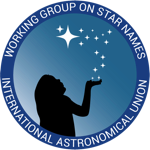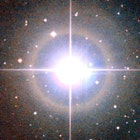Andromeda–Indus
Constellations – 1
Ian Ridpath (Member, IAU Working Group on Star Names)
THE CONSTELLATION NAMES and three-letter abbreviations in this table are those officially recognized by the International Astronomical Union (IAU), astronomy’s governing body. The original list was agreed in 1922 at the IAU’s first-ever General Assembly – click for a scan of the published list, and a discussion of how the choice of names came about. These names, along with the first official constellation boundaries, were enshrined in two IAU books authored by the Belgian astronomer Eugène Delporte (1882–1955), Délimitation scientifique des constellations and Atlas Céleste, both published in 1930. These books by Delporte remain the definitive references on the naming and delineation of the constellations.
Unfortunately, the IAU itself upset this happy consensus in 1932 when it agreed a second list of names with alternative four-letter abbreviations. In this second list, Corona Australis became ‘Corona Austrina’. In 1955 the IAU repealed these alternative four-letter abbreviations but failed to correct the Corona Australis/Corona Austrina confusion. Corona Austrina continued to appear in the constellation list given by the IAU on its own website until 2008, as did the long-defunct constellation Argo, although the rest of the astronomical community followed the Delporte books. These anomalies have now been rectified – see the IAU’s page on the constellations.
The constellation areas in the table are those calculated by A. E. Levin (Handbook of the British Astronomical Association, 1935; reprinted 1972). I have rounded the areas in square degrees to one decimal place, and the percentages of sky coverage to three decimal places. Levin gave separate areas for Serpens Caput and Serpens Cauda, two halves of the same constellation, but here I have combined them into one.
For details of the history and mythology of each constellation, see my Star Tales pages.
For a discussion on names of individual stars, see my page on Star Names.
Constellation
Genitive
Abbr.
Area
(square
degs.)
Area
of sky
(%)
Order
of
size
Visibility range
(full)
Visibility range
(partial)
Number
of stars
≤ 6.5*
Andromeda
Andromedae
And
722.3
1.751
19
90°N – 37°S
37°S – 68°S
152
1
Antlia
Antliae
Ant
238.9
0.579
62
49°N – 90°S
49°N – 65°N
42
6
Apus
Apodis
Aps
206.3
0.500
67
7°N – 90°S
7°N – 22°N
39
3
Aquarius
Aquarii
Aqr
979.9
2.375
10
65°N – 86°S
90°N – 65°N
172
1
Aquila
Aquilae
Aql
652.5
1.582
22
78°N – 71°S
90°N – 78°N,
71°S – 90°S
124
1
Ara
Arae
Ara
237.1
0.575
63
22°N – 90°S
44°N – 22°N
71
1
Aries
Arietis
Ari
441.4
1.070
39
90°N – 58°S
58°S – 79°S
86
1
Auriga
Aurigae
Aur
657.4
1.594
21
90°N – 34°S
34°S – 62°S
152
1
Boötes
Boötis
Boo
906.8
2.198
13
90°N – 35°S
35°S – 82°S
144
1
Caelum
Caeli
Cae
124.9
0.303
81
41°N – 90°S
62°N – 41°N
20
6
Camelopardalis
Camelopardalis
Cam
756.8
1.835
18
90°N – 3°S
3°S – 37°S
152
4
Cancer
Cancri
Cnc
505.9
1.226
31
90°N – 57°S
57°S – 83°S
104
1
Canes Venatici
Canum Venaticorum
CVn
465.2
1.128
38
90°N – 37°S
37°S – 62°S
59
5
Canis Major
Canis Majoris
CMa
380.1
0.921
43
56°N – 90°S
78°N – 56°N
147
1
Canis Minor
Canis Minoris
CMi
183.4
0.444
71
89°N – 77°S
77°S – 90°S
47
1
Capricornus
Capricorni
Cap
413.9
1.003
40
62°N – 90°S
78°N – 62°N
81
1
Carina
Carinae
Car
494.2
1.198
34
14°N – 90°S
39°N – 14°N
225
7
Cassiopeia
Cassiopeiae
Cas
598.4
1.451
25
90°N – 12°S
12°S – 43°S
157
1
Centaurus
Centauri
Cen
1060.4
2.571
9
25°N – 90°S
59°N – 25°N
281
1
Cepheus
Cephei
Cep
587.8
1.425
27
90°N – 1°S
1°S – 36°S
152
1
Cetus
Ceti
Cet
1231.4
2.985
4
65°N – 79°S
90°N – 65°N,
79°S – 90°S
189
1
Chamaeleon
Chamaeleontis
Cha
131.6
0.319
79
7°N – 90°S
14°N – 7°N
31
3
Circinus
Circini
Cir
93.4
0.226
85
19°N – 90°S
34°N – 19°N
39
6
Columba
Columbae
Col
270.2
0.655
54
46°N – 90°S
62°N – 46°N
68
4
Coma Berenices
Comae Berenices
Com
386.5
0.937
42
90°N – 56°S
56°S – 77°S
66
2
Corona Australis
Coronae Australis
CrA
127.7
0.310
80
44°N – 90°S
53°N – 44°N
46
1
Corona Borealis
Coronae Borealis
CrB
178.7
0.433
73
90°N – 50°S
50°S – 64°S
37
1
Corvus
Corvi
Crv
183.8
0.446
70
65°N – 90°S
78°N – 65°N
29
1
Crater
Crateris
Crt
282.4
0.685
53
65°N – 90°S
83°N – 65°N
33
1
Crux
Crucis
Cru
68.4
0.166
88
25°N – 90°S
34°N – 25°N
49
4
Cygnus
Cygni
Cyg
804.0
1.949
16
90°N – 28°S
28°S – 62°S
262
1
Delphinus
Delphini
Del
188.5
0.457
69
90°N – 69°S
69°S – 87°S
44
1
Dorado
Doradus
Dor
179.2
0.434
72
90°S – 20°N
41°N – 20°N
29
3
Draco
Draconis
Dra
1083.0
2.625
8
90°N – 4°S
4°S – 42°S
211
1
Equuleus
Equulei
Equ
71.6
0.174
87
90°N – 77°S
77°S – 87°S
16
1
Eridanus
Eridani
Eri
1137.9
2.758
6
32°N – 89°S
90°N – 32°N
194
1
Fornax
Fornacis
For
397.5
0.964
41
50°N – 90°S
66°N – 50°N
59
6
Gemini
Geminorum
Gem
513.8
1.245
30
90°N – 55°S
55°S – 80°S
119
1
Grus
Gruis
Gru
365.5
0.886
45
33°N – 90°S
53°N – 33°N
55
3
Hercules
Herculis
Her
1225.1
2.970
5
90°N – 38°S
38°S – 86°S
245
1
Horologium
Horologii
Hor
248.9
0.603
58
23°N – 90°S
50°N – 23°N
30
6
Hydra
Hydrae
Hya
1302.8
3.158
1
54°N – 83°S
90°N – 54°N
238
1
Hydrus
Hydri
Hyi
243.0
0.589
61
8°N – 90°S
32°N – 8°N
33
3
Indus
Indi
Ind
294.0
0.713
49
15°N – 90°S
43°N – 15°N
42
3
* NOTES ON COLUMN HEADINGS:
Visibility range (full) gives the range of latitudes from which each constellation rises fully above the horizon at some time. Stars close to the horizon will be considerably dimmed by atmospheric extinction.
Visibility range (partial) gives the latitudes from which the constellation only ever rises partly above the horizon. Constellations which never rise more than a few degrees above the horizon from a given latitude will be effectively unobservable.
Number of stars ≤6.5 gives the number of stars within the constellation of magnitude 6.5 and brighter as listed in the Hipparcos Catalogue.
Origin:
1. Original Greek constellations listed by Ptolemy in the Almagest
2. Considered by the Greeks as part of Leo; made separate by Caspar Vopel in 1536, followed by Gerardus Mercator in 1551.
3. The 12 southern constellations of Pieter Dirkszoon Keyser and Frederick de Houtman
4. Constellations added by Petrus Plancius
5. Seven constellations of Johannes Hevelius
6. The 14 southern constellations of Nicolas Louis de Lacaille
7. Part of the original Greek constellation Argo Navis, dismantled in the 18th century by Nicolas Louis de Lacaille.
Who were Ptolemy, Keyser, de Houtman, Plancius, Hevelius, and Lacaille? For more on the origin and originators of the constellations, see Chapter One of Ian Ridpath’s Star Tales.

